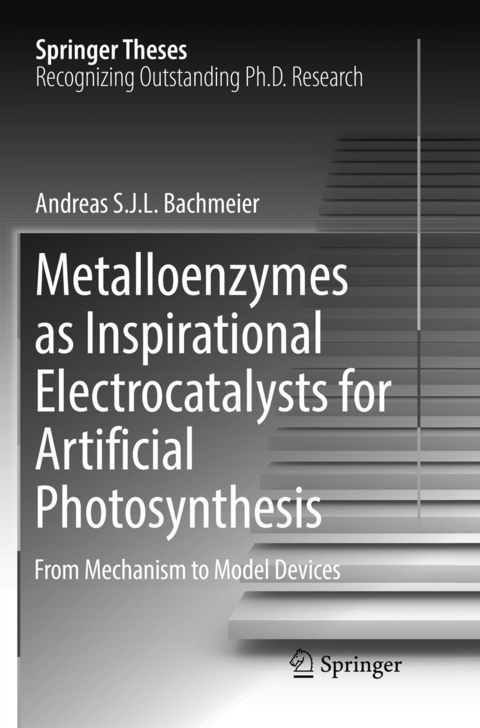
Metalloenzymes as Inspirational Electrocatalysts for Artificial Photosynthesis
Springer International Publishing (Verlag)
978-3-319-83654-6 (ISBN)
This thesis describes a series of investigations designed to assess the value of metalloenzymes in systems for artificial and adapted photosynthesis. The research presented explores the interplay between inherent enzyme properties such as structure, rates and thermodynamics, and the properties of the semiconducting materials to which the enzyme is attached. Author, Andreas Bachmeier provides a comprehensive introduction to the interdisciplinary field of artificial photosynthesis, allowing the reader to grasp the latest approaches being investigated, from molecular systems to heterogeneous surface catalysis. Bachmeier's work also uses metalloenzymes to highlight the importance of reversible catalysts in removing the burden of poor electrocatalytic rates and efficiencies which are common characteristics for most artificial photosynthesis systems. Overall, this thesis provides newcomers and students in the field with evidence that metalloenzymes can be used to establish new directionsin artificial photosynthesis research.
Andreas Bachmeier studied chemistry at the University of Erlangen, Germany, where he was first introduced to the science of solar energy conversion. In addition, he was a scholar of the Bavarian Elite Academy, attending lectures on economics, philosophy, psychology, and other related disciplines. Andreas prepared his Diploma thesis in artificial photosynthesis under the guidance of Dr. Heinz Frei at Lawrence Berkeley National Laboratory, USA; work, for which he was awarded the 'Zerweck' prize of the University of Erlangen. Following a year in the chemical industry working in Novara (Italy) and Munich, he moved to the United Kingdom to pursue his doctoral studies in biological inorganic chemistry at the University of Oxford, where he worked, as St John's College Graduate Scholar, under the supervision of Prof. Fraser Armstrong FRS. Upon finishing his doctoral work, Andreas joined the catalyst business of specialty chemicals group Clariant in 2015. Currently his, work centres on projects dealing with selective hydrogenation and monomer purification / contaminant removal.
Introduction.- Theory of experimental techniques.- The mechanism of [FeFe]-hydrogenases - How Aldehydes Inhibit H2 Evolution.- The Direct Electrochemistry of Fuel-Forming Enzymes on Semiconducting Electrodes: How Light-Harvesting Semiconductors can Alter The Bias of Reversible Electrocatalysts in Favour of H2 Production and CO2 Reduction.- Selective Visible-Light-Driven CO2 Reduction on a p- type Dye-Sensitised NiO Photocathode.- A Multi-Haem Flavoenzyme as a Solar Conversion Catalyst.- Conclusions and Perspectives.- Experimental Section.- Bibliography.
| Erscheinungsdatum | 20.02.2019 |
|---|---|
| Reihe/Serie | Springer Theses |
| Zusatzinfo | XXVI, 252 p. 139 illus., 112 illus. in color. |
| Verlagsort | Cham |
| Sprache | englisch |
| Maße | 155 x 235 mm |
| Gewicht | 433 g |
| Themenwelt | Naturwissenschaften ► Biologie ► Biochemie |
| Naturwissenschaften ► Chemie ► Physikalische Chemie | |
| Technik ► Elektrotechnik / Energietechnik | |
| Schlagworte | Artificial Photosynthesis • Hydrogenases • Metalloenzymes • Photoelectrocatalysis • Reversible Electrocatalysts |
| ISBN-10 | 3-319-83654-4 / 3319836544 |
| ISBN-13 | 978-3-319-83654-6 / 9783319836546 |
| Zustand | Neuware |
| Haben Sie eine Frage zum Produkt? |
aus dem Bereich


